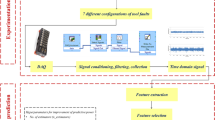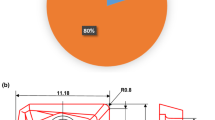Abstract
This study aimed to compare the performance of three machine learning (ML) models, including support vector regression (SVR), random forest (RF), and extreme learning machine (ELM) for kerf width prediction of pulsed laser cutting. Selected features from the optimal base wavelet transformation of vibration signals from the optimal base wavelet selection were adopted as the inputs to the ML models. Averaged kerf width of a straight cut of a 0.1 mm thickness silicon steel sheet was chosen as the output. The performance comparison of three ML models was divided into two stages. In the first stage, the effects of varying the validation data size and data randomness analyses were investigated using training data. In the second stage, the prediction accuracy of these machine learning models on testing data was compared. The results from the first stage revealed that the RF model emerged to be the best model in the validation data size and random state analyses with averaged mean average percentage error (MAPE) scores being of 5.32% and 7.61%, respectively. Compared with the SVR and ELM models, the RF model had the least discrepancy between the MAPE scores, training (2.83%) and testing (1.69%), in the second stage of analysis. This indicates that the selected vibration features from the optimal base wavelet selection combined with the RF model are efficient for forecasting the straight kerf width of the workpiece by pulsed laser cutting.

















Similar content being viewed by others
Data availability
The datasets generated during and/or analyzed during the current study are available from the corresponding author on reasonable request.
References
Nguyen TH, Lin CK, Tung PC, Nguyen-Van C, Ho JR (2020) An extreme learning machine predicting kerf waviness and heat affected zone in pulsed laser cutting of thin non-oriented silicon steel. Opt Lasers Eng 134:1–10. https://doi.org/10.1016/j.optlaseng.2020.106244
Emura M, Landgraf FJG, Ross W, Barreta JR (2003) The influence of cutting technique on the magnetic properties of electrical steels. J Magn Magn 254–255:358–360. https://doi.org/10.1016/S0304-8853(02)00856-9
Pandey AK, Dubey AK (2013) Modeling and optimization of kerf taper and surface roughness in laser cutting of titanium alloy sheet. J Mech Sci Technol 27(7):2115–2124. https://doi.org/10.1007/s12206-013-0527-7
Ghany KA, Newishy M (2005) Cutting of 1.2 mm thick austenitic stainless steel sheet using pulsed and CW Nd: YAG laser. J Mater Process Technol 168:438–447. https://doi.org/10.1016/j.jmatprotec.2005.02.251
Nguyen DT, Ho JR, Tung PC, Lin CK (2021) An improved real-time temperature control for pulsed laser cutting of non-oriented electrical steel. Opt Laser Technol 136:1–12. https://doi.org/10.1016/j.optlastec.2020.106783
Tsai MJ, Li CH, Chen CC (2008) Optimal laser-cutting parameters for QFN packages by utilizing artificial neural networks and genetic algorithm. J Mater Process Technol 208:270–283. https://doi.org/10.1016/j.jmatprotec.2007.12.138
Rao S, Sheti A, Das AK, Mandal N, Kiran P, Gosh R, Dixit AR, Mandal A (2017) Fiber laser cutting of CFRP composites and process optimization through response surface methodology. Mater Manuf Processes 32(14):1612–1621. https://doi.org/10.1080/10426914.2017.1279296
Nguyen TH, Lin CK, Tung PC, Nguyen-Van C, Ho JR (2021) Artificial intelligence-based modeling and optimization of heat-affected zone and magnetic property in pulsed laser cutting of thin nonoriented silicon steel. Int J Adv Manuf Technol 113:3225–3240. https://doi.org/10.1007/s00170-021-06847-4
Wu TY, Lei KW (2019) Prediction of surface roughness in milling process using vibration signal analysis and artificial neural network. Int J Adv Manuf Technol 102:305–314. https://doi.org/10.1007/s00170-018-3176-2
Lin YC, Wu KD, Shih WC, Hsu PK, Hung JP (2020) Prediction of surface roughness based on cutting parameters and machining vibration in end milling using regression method and artificial neural network. App Sci 10(11):3941. https://doi.org/10.3390/app10113941
Upadhyay V, Jain PK, Mehta NK (2013) In-process prediction of surface roughness in turning of Ti-6Al-4V alloy using cutting parameters and vibration signals. Measurement 46:154–160. https://doi.org/10.1016/j.measurement.2012.06.002
Wu D, Jennings C, Terpenny J, Gao RX, Kumara S (2017) A comparative study on machine learning algorithms for smart manufacturing: tool wear prediction using random forest. ASME J Manuf Sci Eng 139(7):071018. https://doi.org/10.1115/1.4036350
Abu-Mahfouz I, El Ariss O, Esfakur Rahman AHM, Banerjee A (2017) Surface roughness prediction as a classification problem using support vector machine. Int J Adv Manuf Technol 92:803–815. https://doi.org/10.1007/s00170-017-0165-9
Yongbin Y, Bagherzadeh SA, Azimy H, Akbari M, Karimipour A (2020) Comparison of the artificial neural network model prediction and the experimental results for cutting region temperature and surface roughness in laser cutting of AL6061T6 alloy. Infrared Phys Technol 108:1–8. https://doi.org/10.1016/j.infrared.2020.103364
Madić M, Radovanović M (2012) Comparative modeling of CO2 laser cutting using multiple regression analysis and artificial neural network. Int J Phys Sci 7(16):2422–2430
Anicic O, Jović S, Skrijelj H, Nedić B (2017) Prediction of laser cutting heat affected zone by extreme learning machine. Opt Lasers Eng 88:1–4. https://doi.org/10.1016/j.optlaseng.2016.07.005
Fang N, Pai PS (2018) A new computational intelligence approach to predicting the machined surface roughness in metal machining. Int J of Mach Learn Comput 8:524–529
Kulkarni PG, Sahasrabudhe AD (2017) Investigations on mother wavelet selection for health assessment of lathe bearings. Int J Adv Manuf Technol 90:3317–3333. https://doi.org/10.1007/s00170-016-9664-3
Rodrigues AP, D’Mello G, Pai PS (2016) Selection of mother wavelet for wavelet analysis of vibration signals in machining. J Mech Eng Autom 6(5A):81–85
Ruqiang Y, Robert XG (2009) Base wavelet selection for bearing vibration signal analysis. Int J of Wavelets Multiresolution Inf Process 7(4):411–426. https://doi.org/10.1142/S0219691309002994
Kusuma AI, Huang YM (2022) Product quality prediction using vibration signals in pulsed laser cutting, Presented at The 28th International Congress on Sound and Vibration (ICSV28), Singapore
Kusuma AI, Huang YM (2022) Product quality prediction in pulsed laser cutting of silicon steel sheet using vibration signals and deep neural network. J Intell Manuf. https://doi.org/10.1007/s10845-021-01881-1
Kwak JS (2006) Application of wavelet transform technique to detect tool failure in turning operations. Int J Adv Manuf Technol 28:1078–1083. https://doi.org/10.1007/s00170-004-2476-x
Liu H (2011) Feature Selection. In: Sammut C., Webb G.I. (eds) Encyclopedia of Machine Learning. Springer, Boston, MA. https://doi.org/10.1007/978-0-387-30164-8_306
Lee SH, Kim KY, Shin Y (2020) Effective feature selection method for deep learning-based automatic modulation classification scheme using higher-order statistics. App Sci 10:1–14. https://doi.org/10.3390/app10020588
Elgeldawi E, Sayed A, Galal AR, Zaki AM (2021) Hyperparameter tuning for machine learning algorithms used for arabic sentiment analysis. Informatics 8:79. https://doi.org/10.3390/informatics8040079
Pedregosa F et al (2011) Scikit-learn: machine learning in Python. J Mach Learn Res 12(85):2825–2830
Drucker H, Burges CJC, Kaufman L, Smola A, Vapnik V (1997) Support vector regression machines. Adv Neural Inf Process Syst 9:155–161
Zhi-qiang J, Hang-guang F, Ling-jun L (2005) Support vector machine for mechanical faults classification. J Zhejiang Univ-Sci A 6:433–439. https://doi.org/10.1631/jzus.2005.A0433
Sun J, Rahman M, Wong YS, Hong GS (2004) Multiclassification of tool wear with support vector machine by manufacturing loss consideration. Int J Mach Tools Manuf 44:1179–1187. https://doi.org/10.1016/j.ijmachtools.2004.04.003
Çaydaş U, Ekici S (2012) Support vector machines models for surface roughness prediction in CNC turning of AISI 304 austenitic stainless steel. J Intell Manuf 23:639–650. https://doi.org/10.1007/s10845-010-0415-2
Seyedzadeh S, Rahimian FP, Glesk I, Roper M (2018) Machine learning for estimation of building energy consumption and performance: a review. Vis in Eng 6(5):1–20. https://doi.org/10.1186/s40327-018-0064-7
Cao LJ, Tay FEH (2003) Support vector machine with adaptive parameters in financial time series forecasting. IEEE Trans Neural Netw 14(6):1506–1518. https://doi.org/10.1109/TNN.2003.820556
Jurkovic Z, Cukor G, Brezocnik M, Brajkovic T (2016) A comparison of machine learning methods for cutting parameters prediction in high speed turning process. J Intell Manuf 29:1683–1693. https://doi.org/10.1007/s10845-016-1206-1
Breiman L (2001) Random forests. Mach Learn 45:5–32. https://doi.org/10.1023/A:1010933404324
Yang BS, Di X, Han T (2008) Random forests classifier for machine fault diagnosis. J Mech Sci Technol 22:1716–1725. https://doi.org/10.1007/s12206-008-0603-6
Huang GB, Zhu QY, Siew CK (2006) Extreme learning machine: theory and applications. Neurocomputing 70(1–3):489–501. https://doi.org/10.1016/j.neucom.2005.12.126
Li DZ, Zheng X, Xie QW, Jin QB (2018) A sequential feature extraction method based on discrete wavelet transform, phase space reconstruction, and singular value decomposition and an improved extreme learning machine for rolling bearing fault diagnosis. Proc Inst Mech Eng E: J Process Mech Eng 232(6):635–649. https://doi.org/10.1177/0954408917733130
Laddada S, Si-Chaib MO, Benkedjouh T, Drai R (2020) Tool wear condition monitoring based on wavelet transform and improved extreme learning machine. Proc Inst Mech Eng C: J Mech Eng Sci 234(5):1057–1068. https://doi.org/10.1177/0954406219888544
Funding
The research reported in this paper was supported by the National Science Council of Taiwan under Grant Numbers MOST 108–2218-E-008–019, and 109–2218-E-008–003.
Author information
Authors and Affiliations
Corresponding author
Ethics declarations
Competing interests
The authors declare no competing interests.
Additional information
Publisher's Note
Springer Nature remains neutral with regard to jurisdictional claims in published maps and institutional affiliations.
Rights and permissions
Springer Nature or its licensor (e.g. a society or other partner) holds exclusive rights to this article under a publishing agreement with the author(s) or other rightsholder(s); author self-archiving of the accepted manuscript version of this article is solely governed by the terms of such publishing agreement and applicable law.
About this article
Cite this article
Kusuma, A.I., Huang, YM. Performance comparison of machine learning models for kerf width prediction in pulsed laser cutting. Int J Adv Manuf Technol 123, 2703–2718 (2022). https://doi.org/10.1007/s00170-022-10348-3
Received:
Accepted:
Published:
Issue Date:
DOI: https://doi.org/10.1007/s00170-022-10348-3




